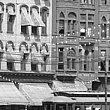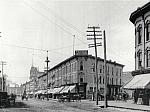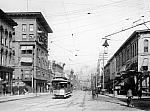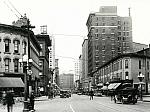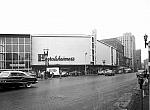
Lighting City Streets, 1850s to 1950s
by GRHC
published: May 30th, 2007
Charles Belknap described how young Henry Baker, who arrived from Holland in 1853, went about his job of lighting the city’s first street lights. “It was in the fifties that the city first afforded street lights. Cedar posts were set up at street corners with a sperm oil lamp at the top. They were lighted at dark by the official lamplighter who went about with a short ladder. At 11 o’clock he made another round to blow them out. There was a contention about the need of illumination on moonlight nights.” Peter Hodenpyl requested in December of 1857 that Baker be appointed lamp lighter, and the council made it official in March of 1858. (Find more information to your right in Related Items)
Gaslight was furnished to Grand Rapids for the first time on November 14, 1857 from the original gas works built at Ottawa and Ferry. The Daily Enquirer & Herald reported the next day, "The Light has Come. We noticed lights burning in several stores on Monroe St. The illuminated signs in Hodenpyl's, Butler's, and Terhune's front windows were the greatest attraction. They consist of brass tubes so formed as to represent those gentlemen's names, and thickly perforated with small holes through which gas escapes and when lighted present a beautiful appearance." The common council of the city authorized twelve street lamps to be erected on Monroe and Canal Sts. between Division and Bridge Sts., but not until 1869 was the west side served with gas by pipes laid across the Pearl Street Bridge. Gas lighting, because of its soft glow, was barely adequate indoors, but out of doors the light scarcely carried any distance beyond the lamppost.
In 1881 the Grand Rapids Electric Light and Power Co. supplied electricity to twelve street lights on Monroe and Canal. They were placed on iron posts at street corners. Lighting was gradually increased until by August of 1888 there were 110 arc lights suspended over the center of the street from cables attached to poles planted at opposite corners diagonally across intersections. Arc lighting, which gave a bright light similar to a mercury vapor lamp, offered a solution to the dim glow of gas street lights.
Also in 1881 the council authorized a test of electric tower lights by the GR Electric Light and Power Co. They put an addition of one hundred feet on the top of the fire alarm bell tower near the corner of Pearl and Ottawa Sts. behind the former home of William Haldane. Eight Brush lanterns of 2000 candle power each were placed at the top of this extension, but the council decided not to adopt the tower system.
However, in 1885 forty towers with direct current arc lights were purchased second-hand from Detroit and the city contracted with GR Electric Light and Power for street lighting until 1898. Sometimes referred to as "moonlight towers," they served the city until about 1916 when the arc lights were replaced with incandescent lighting. The last towers to be removed were those at Hall St. and Madison Ave. and Logan St. at Jefferson Ave.
The city acquired control of its own public lighting in 1899, and built the plant on Market Ave. near Bartlett St. on the east side of the Grand River. A direct current plant, it furnished electricity for the forty tower lights and city owned arc lights. In his annual report for 1899-1900 Mayor George R. Perry said, "The new lighting plant has been put in successful operation during the year and it is something that the city can justly be proud of. It is the envy and admiration of our sister city, Detroit, and a delegation from that city will soon visit us to inspect the model lighting plant of the west."
The switchboard in the newly constructed city lighting plant was the epitome of turn-of-the-century technology. At a time of great controversy over private vs. municipal control of utilities, Mr. Damskey, chair of the lighting committee, reported in the 1901 annual report of the city, "The enemy of municipal ownership of public utilities cannot fail to acknowledge the good results obtained in this city by the building of a municipal lighting plant, both financially and in point of better lights. It is an indisputable fact that our city is better lighted with more lights and better lights at a saving to the municipality of approximately $20,000 per year under city ownership."
In 1911 the equipment was moved from the plant on Market to the water pumping station at Monroe Ave. and Coldbrook St. where direct current equipment continued to supply electricity to the tower lights and arc lights illuminating the city. In 1916 new steam turbine alternating current equipment was installed and the arc lights were phased out. In this 1927 view of the Coldbrook plant two street lights stand in the midst of the Allis Chalmers generators possibly as indicators that power was reaching the city street lights.
The multi-globed fixtures which had adorned the downtown streets for many years were replaced by various styles of incandescent type street lights from 1920-1940. A crew from the street lighting department is shown installing a new lighting fixture on the west side of Division just south of Fulton in 1928. Street lights called "Amish Hats," adopted ca. 1917 and suspended over the center of intersections in residential neighborhoods, were in use until the 1950s.
Almost thirty years later in 1955 the old lights were replaced with fluorescent street lights which were first installed on S. Division between Hall St. and Alger St. 1955 was a year of change in another sense; the Coldbrook Creek storm drain broke through the Coldbrook pumping station walls and flooded the city generating plant equipment. After assessing the damages it was decided that it would be more economical to purchase bulk energy from Consumers Power Co. at a reduced rate than to replace the city-owned equipment..
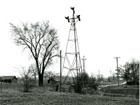
In 1885, Grand Rapids installed 40 towers topped with arc light, to the citizens eventual dismay. Cherry Street was one of the most traveled roads and was densely populated with enough trees to render the tower light there useless. 1898 saw many of the tower lights switched out with drop lights.
Bibliography
Books available at the GR History and Special Collections, Grand Rapids Public Library
- Baker, Robert H. The City of Grand Rapids: Sketches of Principal Industries and Business Houses. B.F. Conrad & Co., 1889.
- Baxter, Albert. History of the City of Grand Rapids, Michigan. New York, Grand Rapids: Munsell & company, 1891.
- Belknap, Charles E. The Yesterdays of Grand Rapids. Grand Rapids: The Dean Hicks Co., 1922.
- Goss, Dwight. History of Grand Rapids and its Industries. Chicago: C. F. Cooper, 1906.

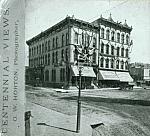
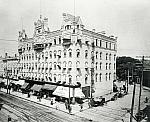

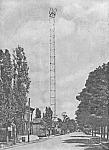
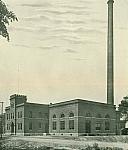
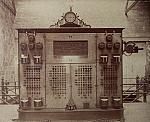
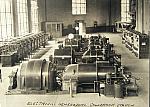
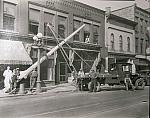
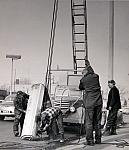
 facebook
facebook